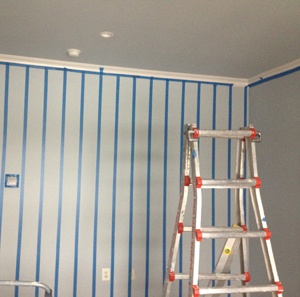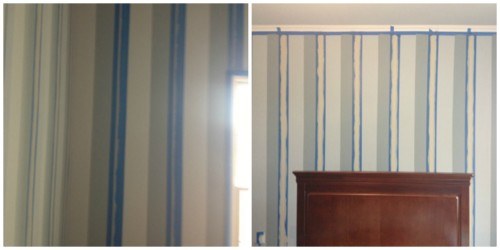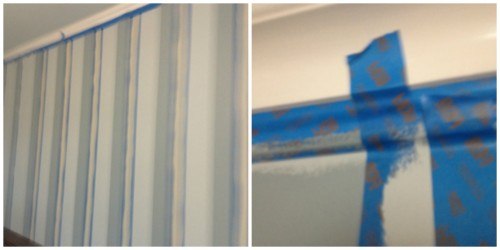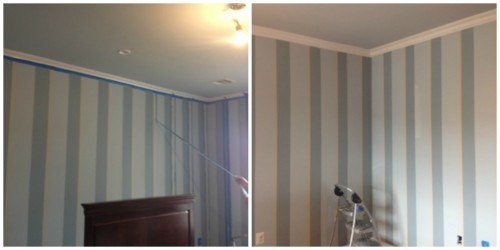
So, how to paint stripes? If you wish you had a taller room and buying a new home is not an option, the next best thing to do would be to paint vertical stripes for the illusion of the height. Because most bedrooms have a closed floor plan, they will look great in the master bedroom, kids’ bedroom or a guest bedroom making the rooms look and feel taller.
Don’t get me wrong, painting stripes is not easy, and that is why painters charge a lot for this kind of job. I have to admit that it can be a daunting task if you have never done it before. But because I have done this many times, I hope to save you time and effort if you follow steps in this post and watch the video.
Here is a step-by-step process that I recorded for painting three colored stripes
.

What you need:
- Paint. Pick close wall paint colors on a paint strip and one complementary color. In this case, I used some of Benjamin Moore’s Silver Gray, Nimbus Gray, and Hazy Skies.
- Measuring Tape – to measure your wall.
- Level or a ruler with a level
- Pencil – to mark your stripes
- Rollers – three at least, one for each color. Get two 3 inch rollers and one 2 1/2 inch roller.
- 1 ½ inches blue tape
- Extender – (optional) to make a small highlight stripe more even.
- Magic Eraser
Step 1 – Base color
Begin by painting the wall with the base color. In this case, Silver Gray by Benjamin Moore, eggshell finish on the walls and flat finish on the ceiling.I prefer three color stripes look. I think that two close colors on a paint strip and one complimentary color for a highlight make the room feel fresh.

Tip: Make sure the tape really sticks closely to the wall and avoid any air bubbles. Use your finger to press the tape really hard.
Step 2 – Taping for the first stripe
Once your base color is dry and ready it is time to paint your first stripe. Measure your wall and find the center using soft drawing pencil. Then mark equally on both sides of your first center pencil mark. This is how wide your first stripe will be. Using level and ruler draw a line vertically up and down the wall. Apply the blue tape right on the line (don’t worry; you will erase it later with Magic Eraser.
Tip: When taping for stripes, it is always better to team up with 2-3 people.

Step 3 – Painting the first stripe.
Use the small roller for painting the first stripe. In this case, I used Benjamin Moore Nimbus Gray for the first stripe. Start in the middle then gently work your way up and down. Go vertically through the whole wall but when you get near the tape, you can gently roll sideways to prevent paint from bleeding.
Tip: Make sure that you’re roller doesn’t absorb too much paint; all you need is a semi-dry roller to avoid any paint bleeding. Always mix the paint before using it.

Step 4 – Taping for the highlight stripe.
So now that you are finished painting the first stripe you will have a two-colored wall. In order to apply the “highlight” stripe, tape off the first tape right on the edge of the existing stripe. Then apply the second tape right next to it. This will be your highlight stripe. The third tape goes right on the edge of the second tape.
Tip: When taping, it is a good idea to leave a little tail all the way on the top/ceiling. This way you will not be confused and know exactly which one is your thin stripe.

Step 5 – Painting the third, ‘highlight’ stripe.
Remove the tape in the middle between the two other tapes. Go ahead and paint the third stripe. Just similar to Step 2, work with an almost semi-dry roller or a paint brush.
Tip: Do not keep the tape for too long on the wall. Try to remove the tape in a couple of hours.

Step 6 – Pull off all the tape.
You can now pull off your tape while the paint is still slightly wet for a smoother seam. If you let the paint dry too much there is a possibility of pulling a bit of paint off with the tape.

There you have it, three -colored stripes on your walls! You can also use laser for marking the stripes but then you need two people because you have to see the laser beam all the way through. So, one person will be up to the ladder and the other one down on the floor. The pencil and level methods I illustrated here might be a little old fashioned but they get the job done.

Word of advice: the thinner is the stripe, the more visible are the mistakes, such as measuring different widths stripes. Try not to paint stripes less than two and a half inches wide. If you stay between six to twelve inches for the main stripe the job will be done much faster. We would like to hear from you. Please post the questions and I will be happy to give you more insights.
Please post your questions here below. I’ll be happy to help you!



How about horizontal stripes? Some says painting your wall with horizontal stripes can make the room look more wider. Is it true? Thanks!
Yes, Michelle, it will make it look wider. It’s just hard to do if you have uneven walls.
Wow, wonderful blog layout! How long have you been blogging for?
you make blogging look easy. The overall look of your site is magnificent, let alone the content!
Cool stuff! I never imagine going for stripes, but the moment I saw the first photo, I wanted to start DIYing my room! One of the problem I can see with this, is the paint getting peeled off along with the tape, so to ensure that from not happening, what kind of tape do you recommend I use?
Keep up the good work! Loving your site!
Blue pro tape. It will never peel off. Besides, never use flat paint when painting stripes. Eggshell finish has more body to it, so it will hold better.
great post i really appreciate this post it seems that there’s a lot of interesting on this site
i will bookmark your page for more new updates on your site. keep it up .
Do you ever seal the tape edges with a clear poly before painting, to prevent bleeding?
Great site here 🙂
Great to hear from the professional! Yes, I do use the clear poly when I want crisp lines, i.e. black and white stripes. For this the goal was to get a “faded” vintage look, so soft lines with half dry roller were used. What would you do?
Thank you for this post. I was looking for a simple way to do stripes and here you are providing a step by step instruction.
Hey, Vernon. I am glad to be helpful. If you have questions, you can always write back. Good luck with your project. I would be very happy to to see it when its done, so post some pictures.